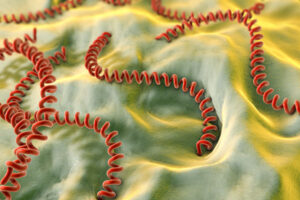ZOONOTIC POTENTIAL OF LEPTOSPIROSIS
Leptospirosis is a zoonotic disease caused by spirochete bacteria belonging to the genus Leptospira. It is common and widespread with reservoirs in domestic and wild animals. Serological classification identifies > 250 known serovars based on the expression of surface lipopolysaccharide. The predominant serovars vary by geographic region and reservoir host. In the United States, L. canicola, grippotyphosa, hardjo, icterohemorrhagiae, and pomona are most common. The most important reservoirs are rodents and a variety of wildlife (e.g., racoons, skunks, squirrels, opossums). These animals typically become infected at a young age with minimal to no disease and shed the organisms in their urine. These organisms can survive for weeks to months in urine-contaminated water and soil, given optimal environmental conditions. The bacteria infects humans and many animal species, including livestock (cattle, pigs, sheep, and goats) and companion animals (dogs, horses, cats). Infection is typically transmitted through ingestion of contaminated food or water, exposure to aerosolized urine or water and direct cutaneous, conjunctival, or mucosal transmission.

The incidence of leptospirosis in dogs in the United States appears to be increasing. Originally leptospirosis affected mostly sporting, working, or herding dogs with extensive outdoor exposure, but smaller breeds and shelter dogs now also appear at increased risk. All ages and breeds are susceptible. Unvaccinated dogs are at highest risk. Dogs are usually infected by exposure to contaminated water, particularly stagnant or slow-moving water like puddles, ponds, or lakes. Another source is exposure to urine contaminated food, soil, or bedding. Leptospirosis may be asymptomatic or can cause severe clinical disease in dogs. The organism has a predilection for the renal tubules, the biliary tract and vascular endothelium. Acute renal failure, hepatic dysfunction and coagulation abnormalities are the most common clinical signs, with pulmonary disease less common. Chronic renal failure develops in 15–25% of cases. In the past, it was believed that cats were not susceptible to infection, but it is now thought that the bacteria might play a role in long term kidney disease. As such, cats are unlikely to show the clinical signs seen in other animals. Cats most likely become infected through feeding on natural reservoir hosts, such as when hunting rodents.
ZOONOTIC POTENTIAL: WHO IS AT RISK?
Leptospirosis is observed worldwide, although it is most prevalent in tropical or sub-tropical climates. It tends to be seasonal, with the late summer and fall peak periods. Environmental and socio-economic factors are thought to explain the distribution and transmission of leptospirosis. Outbreaks tend to occur after heavy rainfall or flooding in endemic areas, especially areas with poor housing and sanitation. In the United States, it is most often diagnosed among travelers who have returned from endemic areas, such as Southeast Asia, Central America and the Caribbean. Puerto Rico and Hawaii have the highest incidence among residents.
Water exposure is a key risk, both domestically and abroad. Outbreaks have also been associated with ecotourism and adventure races. An additional risk factor is living in a city with a large population of rodents, specifically rats (urban leptospirosis). Occupational exposure is thought to be responsible for up to 50% of cases. High risk professions include veterinarians, farmers, fisherman, slaughterhouse workers,

plumbers, sewer workers, miners, and military personnel. Laboratory workers are also at increased risk due to exposure to blood and urine in specimen testing.
In humans, the incubation period is usually 7–12 days. Symptoms vary from asymptomatic to severe, and it is usually a biphasic illness. The first phase, acute or septicemic, begins abruptly and lasts approximately one week. The second phase, or immune phase, is characterized by development of anti-Leptospira antibodies and the excretion of the organism in the urine. The disease may be icteric or anicteric, the former more severe.
Diagnosis of leptospirosis is most commonly based on antibody testing or PCR.
DIAGNOSIS

Diagnosing leptospirosis is a challenge but essential given the zoonotic risk. The organism requires special culture medium and is slow growing. Therefore, diagnosis of leptospirosis is most commonly based on antibody testing or the detection of Leptospira spp. DNA in serum or urine by PCR (Polymerase Chain Reaction).
Microscopic agglutination test (MAT) is still the recommended confirmatory test for canine leptospirosis, despite its numerous limitations
(e.g., negative results in early infection, positive results due to vaccine-associated antibodies). Leptospiral antibodies can also be detected in healthy animals and persistence of antibodies can vary from months to years post exposure. Serologic testing is also a poor predictor of urinary shedding, which may be observed in clinically normal dogs. A four-fold increase or greater between paired acute and convalescent microscopic agglutination test (MAT) titers can be used to confirm a diagnosis.
PREVENTION
The first line of defense is to avoid common sources of contamination. Personal protective equipment is important for high risk professions as is proper laboratory handling of urine samples. While some instrumentation to evaluate urine sediments requires handling and cleaning, Heska’s Element AIM® Automated Artificial Intelligence Microscopy uses an enclosed, disposable cassette, avoiding the use of slides and cover slips, reducing potential exposure. Recreational activities that increase the risk include gardening and water sports (canoeing, swimming, wading and whitewater rafting) in contaminated rivers, streams or lakes, as well as contact with floodwater and contaminated drinking water.

The control of infections in livestock and pets, including vaccination, reduces the risk of human disease, with vaccines available for pigs, cattle, and dogs. They do not however completely prevent infection or the shedding of organisms.
Plus, immunity is serovar specific. There is no vaccine for cats. Domestic animals should not be allowed to urinate in water with human contact. Wildlife reservoirs complicate prevention, so avoiding contact with wildlife and rodent control, especially in urban environments, is recommended. Exposure from dogs with clinical illness contributes to a small percentage of human cases. Suspect cases should only be at risk for zoonotic disease until at least 48–72 hours after initiation of antibiotic treatment, which clears urine shedding. However, some dogs become chronic carriers after exposure, which may or may not be preceded by clinical illness, making these dogs a maintenance host and active zoonotic risk. For this reason, all canine urine samples, regardless of health status, should be considered potentially infectious and treated accordingly. In the clinical setting, if a dog has been confirmed or is suspected to have leptospirosis, appropriate infectious disease protocols should be followed (avoid direct contact with their urine, wear gloves when, and wash hands after, cleaning up urine). Provide a hard non-permeable surface free of organic material for urination and disinfect contaminated areas with a 3–10% bleach solution. The infectious Leptospirosis bacteria are usually not shed in urine until 7–10 days post exposure, but owners and other pets in the household may be at risk from the original source of contamination. Evaluate other pets in the household and advise medical attention if family members become ill. Sanitation and the prevention of contact with contaminated environments or infected wildlife, particularly rodents, can decrease the risk of infection in domestic pets. Animals should not be allowed to drink from contaminated bodies of water.
CONCLUSION
The exposure to water and soil contaminated by the urine of infected animals is the most common route of transmission to humans and domestic animals. Dogs play an important role as indicators of areas with high endemicity for leptospirosis. Although infrequent, zoonotic transmission from dogs to humans can occur. Therefore, diagnosing and preventing canine leptospirosis has important implications for both human and animal health.
References: White AM, Zambrana-Torrelio C. et al. Hotspots of canine leptospirosis in the United States of America. The Veterinary Journal. 222; 2017:29-35 Langston CE and Heuter KJ. Leptospirosis. A re-emerging zoonotic disease. Vet Clinic North America Small Animal Practice. 2003; Jul;33(4):791-807 Harkin KR, Roshto YM et al. Comparison of PCR assay, bacteriologic culture, and serologic testing in assessment of prevalence of urinary shedding of leptospires in dogs. JAVMA, 2002; Vol 222, No. 9, May 1; 2002: 1230-1233 Rodriquez J, Blais M, et al. Serologic and urinary PCR survey of leptospirosis in healthy cats and cats with kidney disease. J Vet Int Med. 2014; 28: 284-293 Leptospirosis Fact Sheet for Clinicians. CDC; January 30, 2018 Sykes JE, Hartman K, et al. Leptospirosis: Protecting your staff and patients. J Vet Int Med. 2011; 25:1-13

